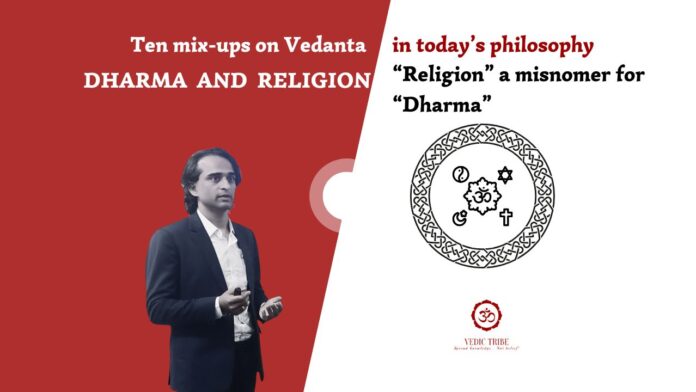“Religion” a misnomer:
In the previous article, we discussed how the term “illusion” is not sufficient to explain the term Maya. In this article, we will discuss another misnomer – “religion” to explain the term “Dharma”.
Dharma is a multifaceted concept in Vedic tradition that is completely different from the Western notion of “religion.”
While religion typically refers to a specific set of beliefs and practices associated with a particular deity or spiritual tradition, Dharma encompasses a broader understanding of cosmic order, moral duty, and spiritual fulfilment.
Different connotations of the term Dharma:
1. Cosmic Law: Dharma represents the fundamental laws of the reality, governing both the natural and spiritual realms. It is the underlying principle that sustains the cosmos and beyond.
2. Moral Duty: Dharma prescribes the righteous path of action for individuals, guiding them towards ethical behaviour and spiritual growth. It is the duty to fulfil one’s role in society and the universe.
3. Nature of beings: The term Dharma is also used to denote the inherent or apparent nature of both animate & inanimate beings.
4. Spiritual Path: Dharma is the path that leads to liberation or enlightenment.
5. The way of Parabrahman: The activities of Parabrahman, including those apparent in the movement of cosmos and also those not apparent – are also called Dharma.
Essential aspects of “Religion”:
1. Belief in a personal God: Religions, especially the organized religions – demand “belief” in a personal God and is the essential requirement for salvation.
2. Holy book: Holy book is the final authority.
3. Prayer: Mandatory prayers or mandatory gathering of prayer
4. One messiah: Religions especially Abrahamic religions demand belief in only “one messiah” and his teachings.
5. Male God: The personal God is essentially a male figure.
Dharma: A Holistic Perspective
Unlike religion, which often focuses on strict belief system, Dharma is a holistic approach to existence that encompasses all aspects of human existence & experience. It is a dynamic concept that evolves with time and circumstance, yet remains rooted in eternal principles (Sanatana dharma).
In addition to being eternal (Sanatana dharma), it takes form of social order (samajika dharma) differing from place & time and it can also take form of individual’s in-principal existence (swa-dharma).
Sanatana Dharma (Eternal Dharma):
– This refers to the timeless, universal principles that underpin existence. It’s the eternal order that governs the cosmos. This remains constant
– Think of it as the fundamental “laws” of spiritual and moral existence.
Samajika Dharma (Social Dharma):
– This aspect of Dharma relates to the social order and the duties that individuals have within their communities.
– It acknowledges that social structures and norms vary across different places and times.
Therefore, the specific expressions of Samajika Dharma can change to reflect the unique circumstances of a society.
Swa-Dharma (One’s Own Dharma):
– This focuses on the individual’s personal duties and responsibilities based on their inherent nature, abilities, and stage of life. Swa-Dharma is about aligning one’s actions with their inner being and fulfilling their potential.
– It emphasizes the importance of fulfilling one’s unique purpose and contributing to the greater whole. This is unique for all individual consciousness across cosmos.
By understanding the dynamic meaning of Dharma, we can appreciate the depth and breadth of Vedic tradition. It is a timeless wisdom that offers guidance for living a meaningful life and achieve spiritual growth.
Key takeaways:
The term “dharma” has a varied conations (only few covered in this article) which is totally different from “religion”. When someone uses the word religion for Dharma, politely correct them.
In the next article, we will discuss the tenth mix-up – “Creation and Srishti”.
Madhwesh K
Vedic Tribe

